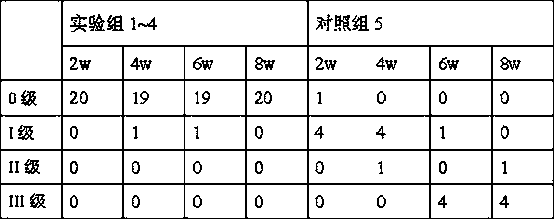A polylactic acid-trimethylene carbonate film doped with polyglycolic acid particles and its preparation method and application
A technology of methyl carbonate and polyglycolic acid, which is applied in the field of sealants, can solve the problems of long duration of mechanical strength, slow degradation speed, and high initial strength, and achieve the effects of shortening retention time, fast degradation speed, and guaranteed strength
- Summary
- Abstract
- Description
- Claims
- Application Information
AI Technical Summary
Problems solved by technology
Method used
Image
Examples
preparation example Construction
[0023] The present invention also includes the preparation method of the polylactic acid-trimethylene carbonate film doped with polyglycolic acid particles, comprising the following steps:
[0024] ①In parts by weight, put 200~500 parts of lactic acid and 100 parts of trimethylene carbonate in a reaction kettle, add 0.15~0.3 parts of stannous octoate under nitrogen protection, and react at 140~160°C after vacuuming After 24 to 48 hours, the reaction solution was obtained;
[0025] ②Add dichloromethane to the reaction solution obtained in step ① to dissolve, then add ethanol and stir to obtain a precipitate, and vacuum-dry the obtained precipitate at 40~50°C for 45~50 hours to obtain a polylactic acid-trimethylene carbonate copolymer; The mass volume ratio of said reaction solution, dichloromethane and ethanol is 1g: 1 ~ 5ml: 1 ~ 3ml;
[0026] 3. step 2. gained polylactic acid-trimethylene carbonate copolymer 5 ~ 15 parts are added in dichloromethane and fully stirred to obtai...
Embodiment 1
[0035] A polylactic acid-trimethylene carbonate film doped with polyglycolic acid particles, in parts by weight, consists of polyglycolic acid particles 1g and polylactic acid-trimethylene carbonate copolymer 15g to form a film with a thickness of 20 μm; The average particle diameter of the polyglycolic acid particles is 10 μm, and the molecular weight is 90,000; the molecular weight of the polylactic acid-trimethylene carbonate copolymer is 100,000.
Embodiment 2
[0037] A polylactic acid-trimethylene carbonate film doped with polyglycolic acid particles, in parts by weight, consists of polyglycolic acid particles 3g and polylactic acid-trimethylene carbonate copolymer 5g to form a film with a thickness of 200 μm; The average particle diameter of the polyglycolic acid particles is 200 μm, and the molecular weight is 110,000; the molecular weight of the polylactic acid-trimethylene carbonate copolymer is 200,000.
PUM
| Property | Measurement | Unit |
|---|---|---|
| thickness | aaaaa | aaaaa |
| particle size | aaaaa | aaaaa |
| particle size | aaaaa | aaaaa |
Abstract
Description
Claims
Application Information
 Login to View More
Login to View More - R&D
- Intellectual Property
- Life Sciences
- Materials
- Tech Scout
- Unparalleled Data Quality
- Higher Quality Content
- 60% Fewer Hallucinations
Browse by: Latest US Patents, China's latest patents, Technical Efficacy Thesaurus, Application Domain, Technology Topic, Popular Technical Reports.
© 2025 PatSnap. All rights reserved.Legal|Privacy policy|Modern Slavery Act Transparency Statement|Sitemap|About US| Contact US: help@patsnap.com

